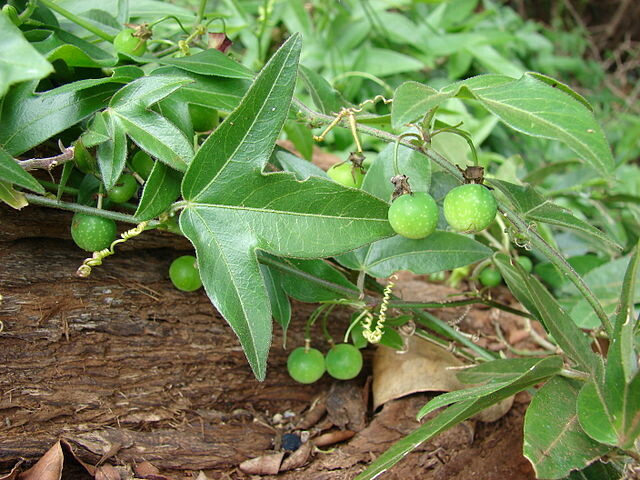Written by Don Richardson


Corkystem Passionvine (Passiflora Suberosa)
Plant Type | Perennial Vine/Ground Cover |
Size | Up to 15’ long |
Sun Exposure | Full sun to partial shade |
Soil Type | Acidic, Neutral - Alkaline |
Soil pH | 6.1 – 7.8 |
Bloom Time | Spring - Summer |
Hardiness Zones | 7b-11a (USDA) |
Native | Is a Florida Native |
Pollination | Self pollinates |
Edible Plant | Yes – Fruit is edible |
Medicinal Plant | Yes |
Any reference to medicinal or culinary use of plants or plant parts should in no way be considered an endorsement by The Ocala Food Forest or its staff. Research is crucial in safe and proper consumption or experimentational use of any plant.
The Passiflora Suberosa is a species of passionflower native to Mexico, Central and South America, and some Caribbean Islands. It is an evergreen vine belonging to the family Passifloraceae. Passiflora Suberosa is a popular ornamental plant due to its beautiful flowers and foliage. In this article, we’ll discuss the basics of this unique plant, including its growth requirements, care tips, and interesting facts.
Growth Requirements
Passiflora Suberosa requires full sun or partial shade and well-draining soil with a neutral pH balance. It prefers warm temperatures between 65°F and 90°F (18°C - 32°C). It will grow up to 15 feet tall if given enough space. Its distinctive purple flowers measure anywhere from 2 to 5 inches across, with each flower containing five petals that are lined with white filaments. When the flowers bloom, they produce a sweet aroma that attracts hummingbirds, bees, and other pollinators. If you plan on growing it indoors, make sure you provide adequate space for the vines or prune them regularly. Since the plant can be quite vigorous in terms of growth, it’s best to keep it contained in a pot or planter box in order to keep its size manageable.
Care Tips
Since the Passiflora Suberosa is native to wet and tropical climates, it thrives in areas with high humidity and plenty of moisture. When planting this species indoors or outdoors, make sure you have well-draining soil that’s rich in organic matter. For optimal growth, give your plant plenty of sunlight (at least 6 hours per day) and water regularly throughout the growing season. During the winter months, keep your plant well-maintained but avoid overwatering or overfertilizing it as these can cause stress or damage to its roots. The Passiflora Suberosa needs regular pruning during the growing season—typically once per month—in order to maintain its shape and size. If left unchecked, this species can become unruly due to its aggressive growth pattern; however, if kept trimmed back properly it will stay healthy and vibrant all year long. Also make sure you check your plants regularly for any signs of pests such as aphids or mealybugs which can damage the foliage if left untreated.
Interesting Facts
Passiflora Suberosa has a long history of medicinal use by indigenous cultures in Mexico, Central America, and South America. The leaves are known for their calming effect on the mind while the flowers are used as a treatment for insomnia due to their sedative properties. Additionally, this species is known for being highly resistant to many common pests making it an ideal choice for home gardeners looking for low maintenance plants that won’t require frequent pest control measures.
Conclusion:
The Passiflora Suberosa is an exotic flowering plant that adds color and beauty to any outdoor space or garden setting. This species of passionflower thrives in warm climates with plenty of humidity and moisture; however, it does require some maintenance in order to keep it healthy throughout the year—including regular pruning and fertilization during the summer months when it’s actively growing. With just a bit of care and attention, however, you can enjoy this gorgeous plant for many years to come!
The Passiflora Suberosa is an exotic flowering plant that adds color and beauty to any outdoor space or garden setting. This species of passionflower thrives in warm climates with plenty of humidity and moisture; however, it does require some maintenance in order to keep it healthy throughout the year—including regular pruning and fertilization during the summer months when it’s actively growing. With just a bit of care and attention, however, you can enjoy this gorgeous plant for many years to come!










0 Comments